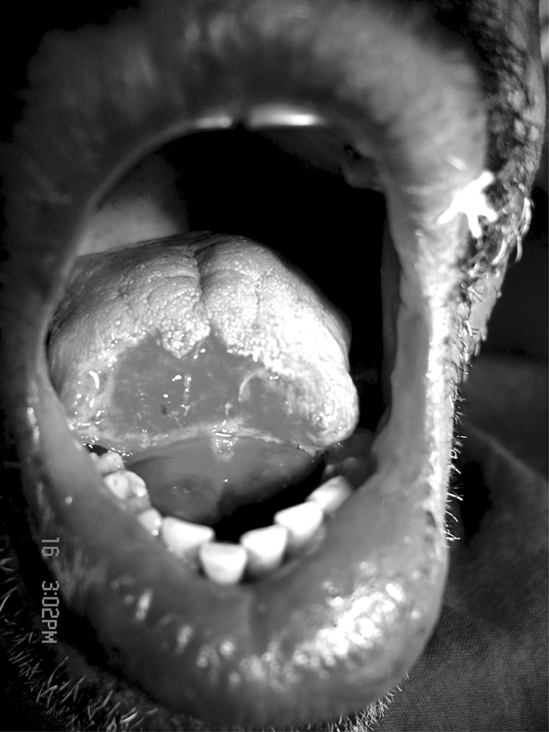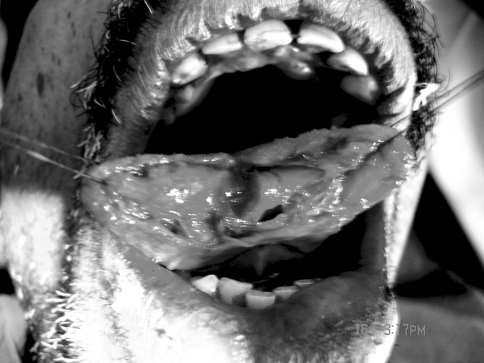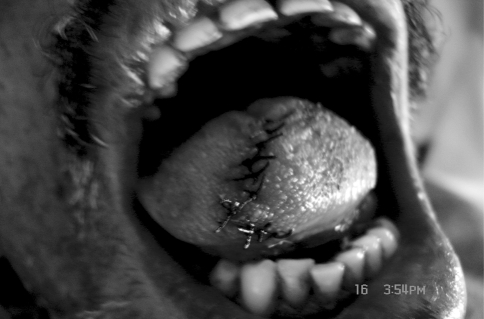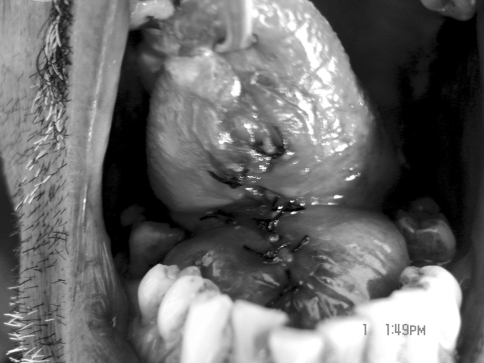Abstract
The tongue is an important structure for speech, mastication and deglutition. Avulsion of a portion of tongue can significantly limit the range of motion thereby impairing its functions. This is the case report of a traumatically amputated tongue which was reconstructed to fulfill its function effectively. Z-plasty is one of the most commonly used soft tissue corrective procedures in plastic surgery. Here we describe the use of a modification of the Z-plasty—multiple series Z-plasty for a tongue frenectomy.
Keywords: Z-plasty, Tongue laceration, Frenectomy, Modified Z-plasty
Case Report
A 46-year-old man presented to the oral surgery department with loss of tissue from the anterior part of the tongue following a fall. The patient had sought primary care at the government hospital and was referred for further management. Clinical examination revealed a contused lower lip which was mildly edematous. Intra oral examination revealed loss of part of anterior two thirds of the tongue including its tip (Fig. 1). A hematoma was present in the floor of the mouth. An OPG was taken to rule out any fractures of the mandible and a routine blood examination was done.
Fig. 1.

Initial clinical presentation
Following assessment of the laceration it was planned to reconstruct the anterior part of the tongue. The patient was taken up for repair of the tongue under local anesthesia. The wound was thoroughly irrigated with saline and debrided. After placing stay sutures, a midline incision was placed to extend the wound further along its dorsal surface till junction between anterior two thirds and posterior one third of the tongue (Fig. 2). Muscle layer was dissected in the midline and the two ends of the tongue were approximated. The tongue was sutured back to its form with a two layer closure using 3-0 vicryl (Fig. 3). The patient was prescribed appropriate antibiotics and analgesics for the postoperative period, satisfactory healing was observed in the postoperative period.
Fig. 2.
Muscle layer dissection with midline incision
Fig. 3.
Tongue sutured back to its form, postoperative
The patient reported after 2 weeks with difficulty in speech. On examination there was slurring of speech which was assessed to be due to shortening of length following the procedure. The length of the tongue following the procedure was found to be 8 mm from tip to the lingual frenum. For correction of speech it was decided to lengthen the tongue using a lingual frenectomy.
The patient was taken up for frenectomy after 2 weeks. The dissection on the ventral surface of the tongue was carried out till the genioglossus muscle (Fig. 4). Multiple Z-plasties in series were used for lengthening of the tongue. Closure of the flaps were done using 3-0 vicryl (Fig. 5). Postoperatively the tongue length was measured and was found to be 14 mm. There was satisfactory improvement in movements of the tongue and speech.
Fig. 4.
Dissection of genioglossus muscle
Fig. 5.
Wound closure with 3-0 vicryl
Discussion
Free tongue is defined as the length of the tongue from the insertion of the lingual frenum into the base and to the tip of the tongue [1, 2]. Clinically acceptable normal range of free tongue is known to be 16 mm or more. A Z-plasty is one of the most widely used techniques in plastic surgery. The usual Z-plasty consists of two identical triangular flaps that transpose synchronously with each other, recruiting tissues from one axis and redistributing tissues along another axis [3]. It has a number of modifications which are practical and applicable. Multiple Z-plasties in series has been used in our case for a number of reasons. The lingual frenum was divided into a number of segments, each with a Z-plasty designed in series. Using multiple small Z-plasties is better than using one large Z-plasty because the need for shortening width to give increased length is less when the Z-plasty is smaller. The change from single to multiple Z-plasty also alters the form of lateral tension and has advantages from a vascular point of view [4]. A limitation of the technique is that the actual lengthening obtained is less than the theoretical lengthening because the field of tension exerted by each Z-plasty impinges on its neighbor, in doing so limiting the overall length [3–5].
Conclusion
Management of routine soft tissue lacerations may bring up challenges which may not be totally anticipated. Z-plasty and its modifications should be a part of the surgeon’s armamentarium to tackle these effectively.
References
- 1.Fonseca RJ (1997) Oral and maxillofacial trauma, vol 2. Saunders, Philadelphia
- 2.Kotlow LA. Ankyloglossia (tongue tie): a diagnosis and treatment quandary. Quintessence Int. 1999;30(4):259–262. [PubMed] [Google Scholar]
- 3.Hudson DA. Some thoughts on choosing a Z-plasty: the Z made simple. Plast Reconstr Surg. 2000;106(3):665–671. doi: 10.1097/00006534-200009030-00024. [DOI] [PubMed] [Google Scholar]
- 4.McGregor IA (1995) Fundamental techniques of plastic surgery, 9th edn. Churchill Livingstone, Edinburgh
- 5.Gahhos FN, Cuono CB. Double-Z rhombic technique for reconstruction of facial wounds. Plast Reconstr Surg. 1990;85(6):869–873. doi: 10.1097/00006534-199006000-00006. [DOI] [PubMed] [Google Scholar]






